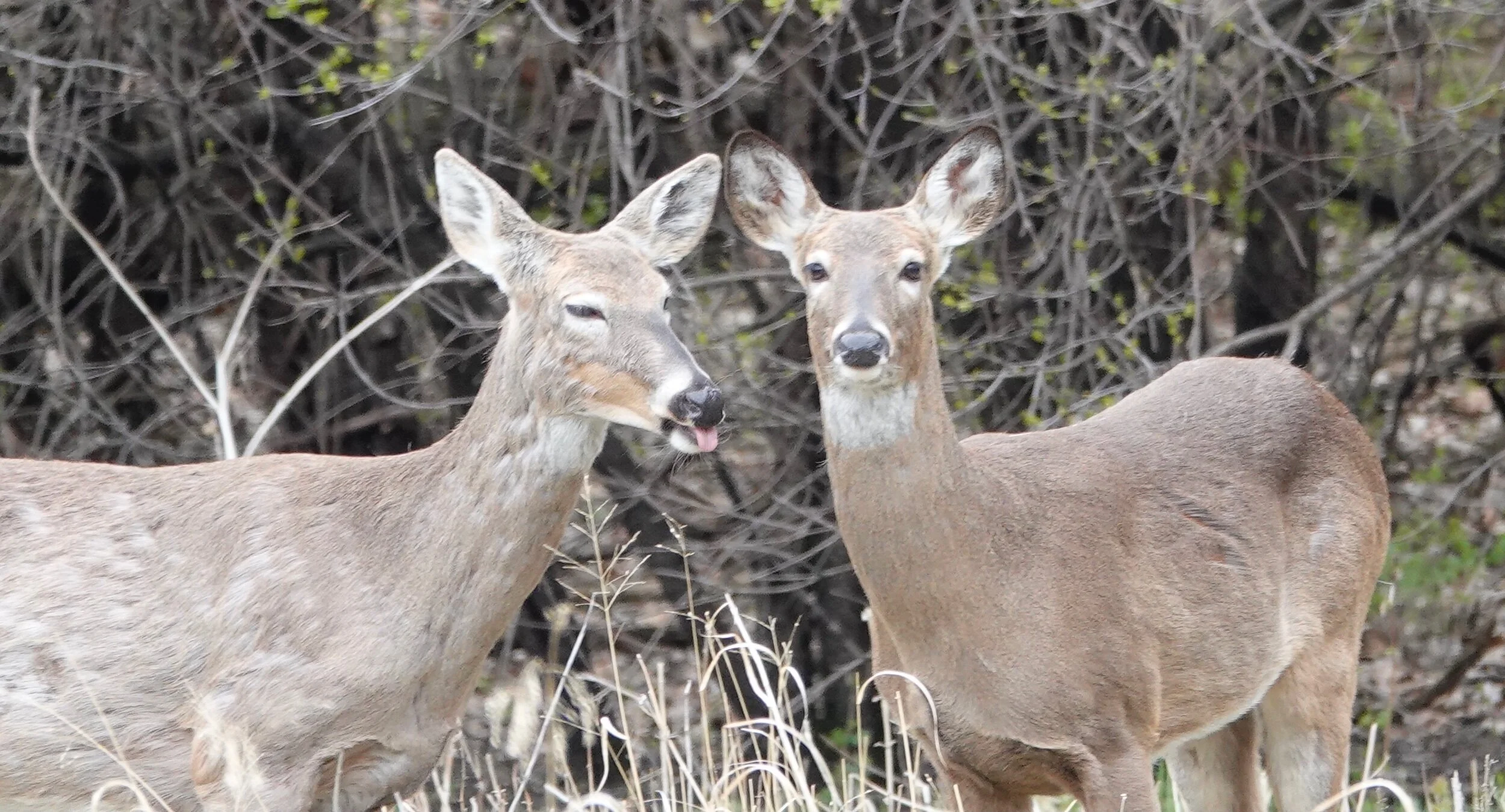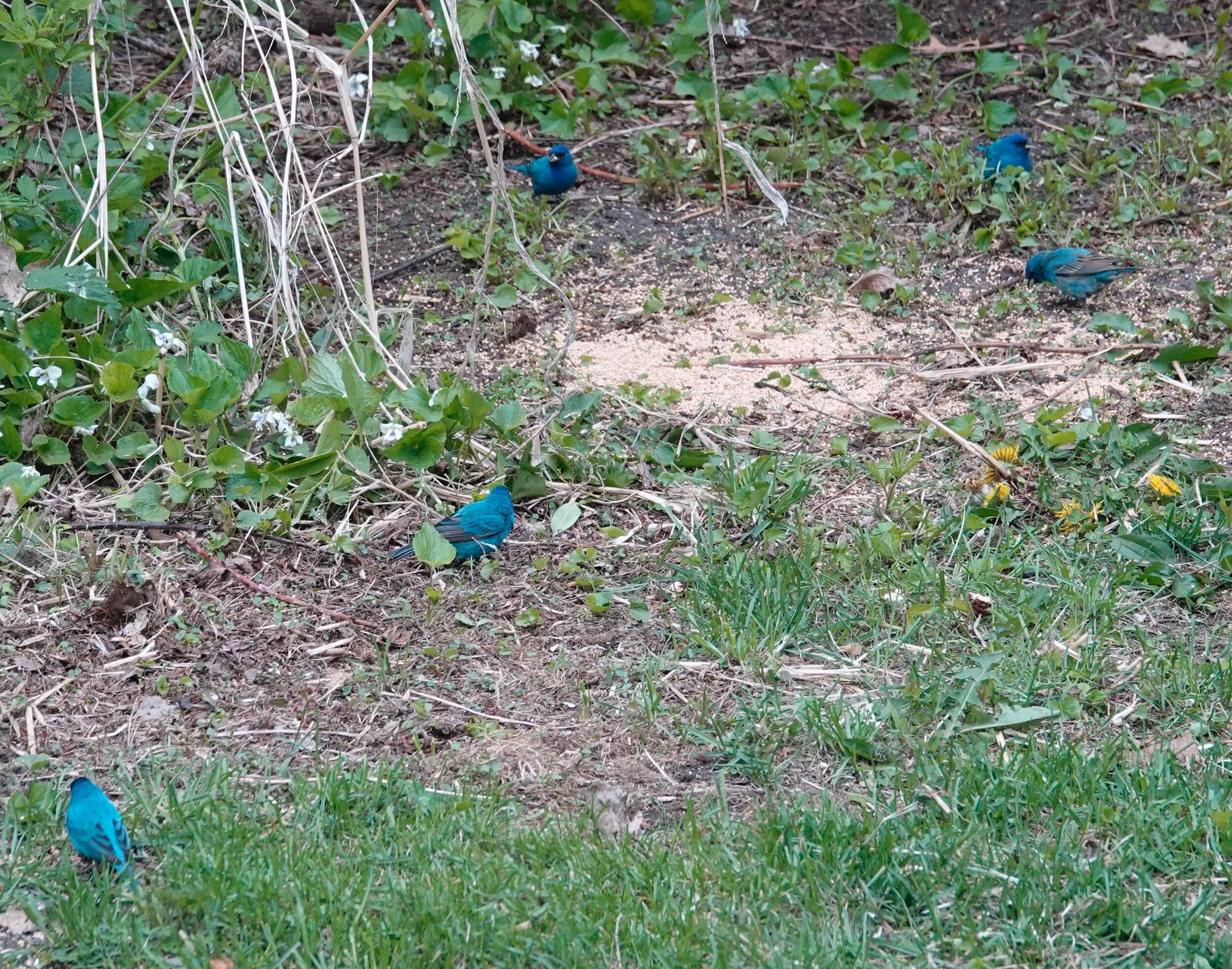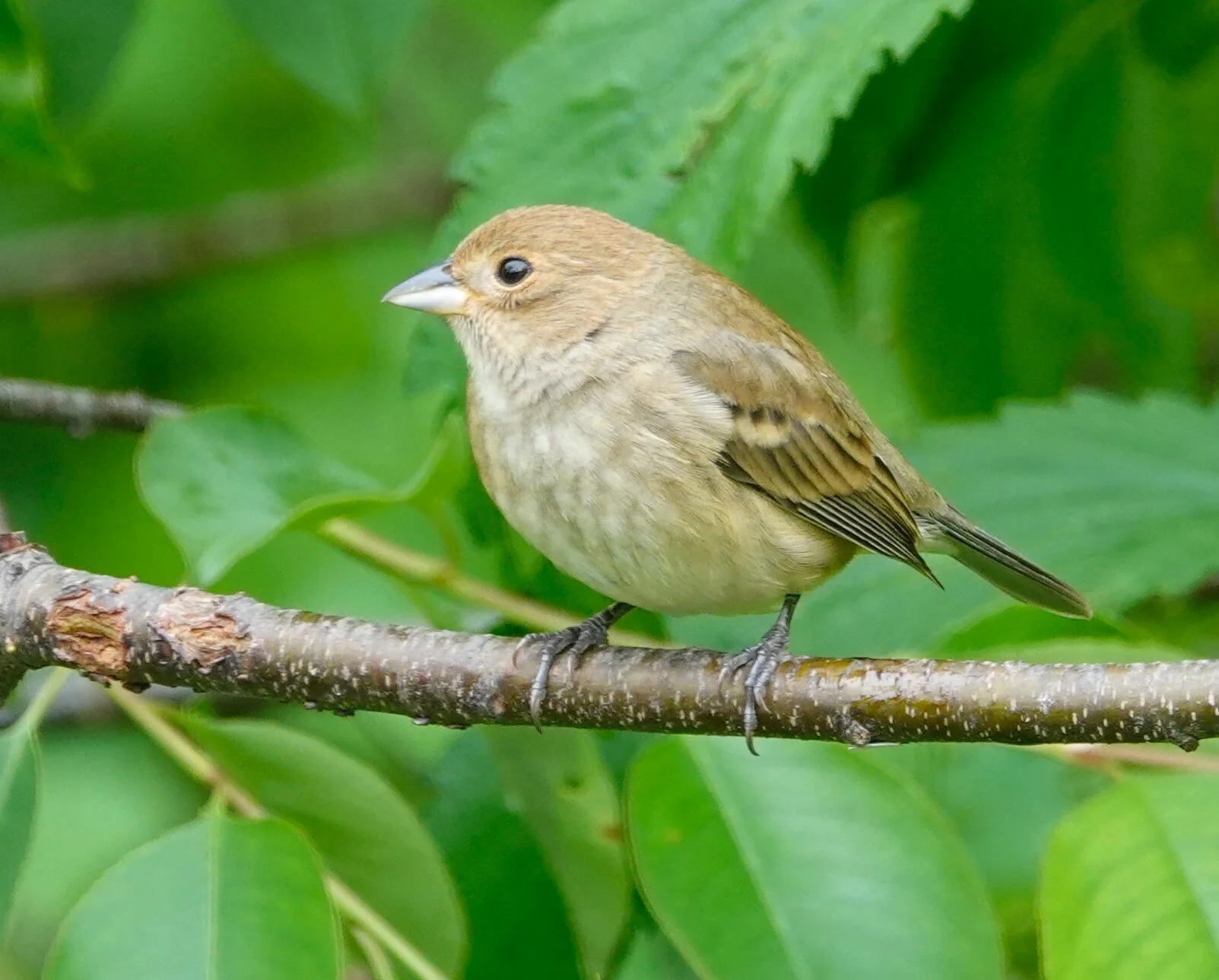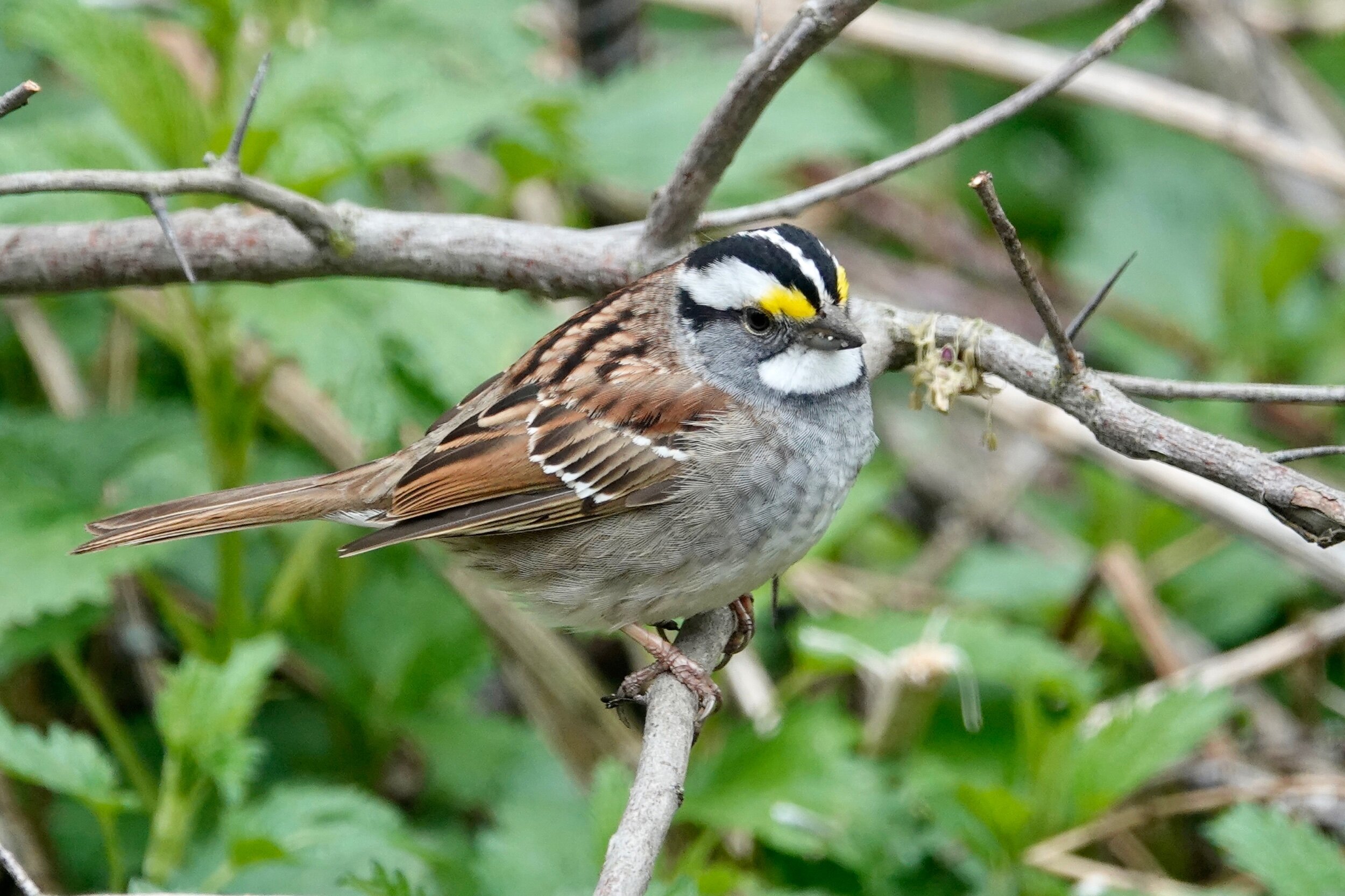Blah, blah, blah.
An Indigo Bunting basketball team has its starting five on the court.
A female Indigo Bunting is lovely.

Blah, blah, blah.

An Indigo Bunting basketball team has its starting five on the court.

A female Indigo Bunting is lovely.

It’s not easy to sneak the sun past this guy. He is not Rooster Cogburn.

When the sap runs, sapsuckers notch holes in trees. A number of other birds. Including hummingbirds, feed at those sap wells.

Little Rickie. The four-letter alpha code used by the U.S. Bird Banding Lab is RCKI, which turns the Ruby-crowned Kinglet into Little Rickie.

Please do the same at all the other mile markers, too.

A Blue Jay dressed for the cold.

Dame's rocket flowers are white, pink, lavender and purple. This plant is confused with native phlox, but phlox has five-petaled flowers and dame’s rocket has four.

Dame's rocket flowers are white, pink, lavender and purple. This plant is confused with native phlox, but phlox has five-petaled flowers and dame’s rocket has four.

Dame's rocket flowers are white, pink, lavender and purple. This plant is confused with native phlox, but phlox has five-petaled flowers and dame’s rocket has four.

The underside of the bill of an Eastern Wood-Pewee is mostly yellow-orange on an adult.

Turkey Vultures keep banker’s hours and don’t go to work until 10 in the morning.

A noisy photo of a noisy Black-necked Stilt.

Wild Geranium or Wild Cranesbill.

Don’t be bitter, find a bittern. The American Bittern is called the belcher-squelcher, mire-drum, slew pumper, bog bull, dunk-a-doo, stake-driver, thunder-pumper, water-belcher and sky-gazer.

Old Blue Eyes. Not Frank Sinatra, but a Double-crested Cormorant.

A meeting of the board.
Naturally
I helped some birders from Utah find Waldo amid a slew of warblers at a state park. The beauty of the warblers (mostly American redstarts), orchard orioles, indigo buntings and Swainson’s thrushes enthralled us. I didn’t have enough eyes to go around.
I’d gotten photos from a column customer in St. Paul. They were of a yellow-eyed hawk peering through a window into a break room located on the 9th floor of an office building. It was a red-tailed hawk, a raptor that in its first year has pale yellowish eyes and as an adult has dark brown eyes. The color change from yellow to brown happens over several years and more quickly in some birds than in others.
A grackle enjoyed the peanuts in the shell I put out for the blue jays and red-bellied woodpeckers. He grabbed one, flew to the ground and pecked the shell open to find the prize inside. How did the grackle repay me? It did a drive-by dropping of droppings that hit the tip of my sandal, missing my toe by the width of a pencil stroke. That’s what happens when you put your best foot forward. Then the bird went off to chase a squirrel.
Q&A
“Do cats kill rats?” They could, but most cats avoid doing so. Cats and rats are more likely to ignore or avoid each other than engage in conflict. Given the choice between attacking a large rat, a bird or a mouse, cats tend to opt for the latter two.
“Are bees unable to see red?” Bees see a range of colors, but not red. While we see colors as combinations of blue, green and red, bees see combinations of blue, green and ultraviolet.
“How do I make hummingbird nectar?” Use a 1:4 ratio of refined white sugar to water. You need water just hot enough to dissolve the table sugar you're mixing in. Don’t use organic, natural or raw sugars. Avoid honey and red dye.
“How did the dragonfly get its name?” In “Folklore of the Dragonfly: A Linguistic Approach” it’s theorized the name dragonfly came about because of an ancient Romanian folktale in which the devil turned a horse ridden by St. George into a giant, flying insect. The Romanian names the people used for this giant insect translated into St. George’s horse, devil’s horse or devil’s fly. The Romanian word for devil was “drac,” also the word for dragon. The book suggests the Romanian name for the devil’s fly evolved into the English “dragonfly.” Swedish folklore holds the devil uses dragonflies to weigh people’s souls.
“Do ladybugs sleep?” Yes, mostly at night, but they don’t close their eyes and fall asleep as we do. They enter a resting period, during which they remain still and unresponsive for hours in tree bark, logs, bushes, cracks in trees, leaves, dense vegetation and ground cover.
“Are owls able to turn their heads all the way around?” As I walked a trail recently, I heard a barred owl call its distinctive "Who cooks for you? Who cooks for you-all?” Owls can rotate their heads 270 degrees in either direction without damaging blood vessels or cutting off blood flow to the brain. The owl has bone and vascular structures running along its neck and into its skull that keep the blood flowing even when the head is swiveled up to 270 degrees. If an owl were human size, the eyes would be the size of grapefruits. Owl eyes face forward and are immovable, providing great binocular vision. Owls compensate for immovable eyes by the ability to rotate their heads. Owls have excellent vision both in daylight and at night.
“Are spiders insects?” They are arachnids as are harvestmen, mites, ticks and scorpions. All arachnids have eight legs, and unlike insects, they don't have antennae.
“Why do bucks shed their antlers?” The prime reason bucks have antlers is to fight with other bucks for dominance. Once the deer breeding season is over, they don’t need them. The antlers become excess weight. When testosterone levels drop, so do antlers.
“How many quills does a porcupine have?” Around 30,000.
Daniel and Kim Otten of Hayward saw a raptor take an adult wood duck and wondered about its identity. It was a peregrine falcon. Other predators of adult wood ducks are the raccoon, fox, great horned owl, barred owl and goshawk. On the subject of peregrine falcons, a Peregrine Falcon nest cam at the Mayo Building in Rochester can be seen at https://www.earthcam.com/usa/minnesota/rochester/falcon/?cam=falcon_mn Another riveting nest cam is the Decorah North Bald Eagle Cam found at
https://youtu.be/VlNV1L9qnrk
Thanks for stopping by
“Spring: the music of open windows.”—Terri Guillemets
“The day the Lord created hope was probably the same day he created Spring.”—Bernard Williams
Do good.
©Al Batt 2021

Red fox kits/pups/cubs are cuter than a bug’s ear. Photo by Al Batt

The good news is that this wasn’t today.

A group of Turkey Vultures is called a wake or a committee.

This Hairy Woodpecker hadn’t given much thought as to what he was wearing. The red patch at the back of the head means the noggin belongs to a male.

Nothing likes milo, not even Milo the Red Squirrel

A Red-bellied Woodpecker has a red eye.

This Indigo Bunting makes me wish I had a tree with blue leaves.

The Rose-breasted Grosbeak displays a few different colors of roses.

Bird fight at the Grape Jelly Corral.

This American Goldfinch is into natural foods.

A pathetic photo of Red-headed Woodpeckers.

A Blue Jay and a peanut. It’s like me carrying a watermelon in my teeth.

A raccoon after hearing some trash talk from another.

The Orchard Oriole. I always thought that would have been a fine model name for an Oldsmobile.
Naturally
Silent shadows moved past me on a walking trail. Vultures were flying between me and the sun. I watched a movie called “Miami Blues.” It wasn’t my cup of tea, but one of its scenes showed vultures flying overhead with the sounds of red-tailed hawks dubbed in.
The insistent whistle of a cardinal provided background music. It’s impossible to ignore a redbird. May brings the musical trills of American toads as they all chime in at once. House wren song accompanied the cardinal as my steps added up. I walked past plantain, which native people called “white man’s footstep.”
Raccoons were noisy. Their mating season is February to March and after a 63-day gestation period, the female gives birth to a litter of 2-6 young in April or May in either hollow trees, woodchuck burrows, culverts, under buildings, etc.
Tiny spring azures are among the first butterflies seen in spring that haven’t hibernated overwinter as adults. They have bright blue upper wings that are apparent as they fly in search of mates or food. They seldom perch with wings open and the undersides of their wings are gray with spots.
Countless 17-year periodical cicadas are emerging in many major media markets, but not in Minnesota. The cicadas are about an inch long and I’ve heard there may be 20,000-40,000 in a single tree. The nymphs had spent their lives 12-24 inches deep in the soil where they fed on tree sap. They are noisy because they are teenagers. Brood X emerges this year. Two broods have gone extinct and a third is declining due to deforestation.
I watched trumpeter swans feed in a shallow wetland. They used their strong webbed feet to dig into the pond bottom for roots, shoots and tubers. Their big feet churn like the swans are on a Peloton bike before they plunge their heads and necks underwater to eat what they’d dislodged.
Speak softly and carry a loaf of bread
A friend came home from grocery shopping to discover a wild turkey tom in his yard. The turkey had been courting a nearby hen. The tom identified the returning shopper as a competitor and shifted into attack mode. My friend retreated swiftly to the deck of his home, but the tom followed him nimbly. The man kicked the turkey twice, but it only encouraged the tom’s assault. The tom put the man’s castle under siege. Finally, in desperation, the man pulled a loaf of bread from his shopping bag and struck the big bird with it. That did the trick and sent the tom into retreat.
Q&A
“I watched a crow dip bread in a birdbath. What was it doing?” Crows dip their food in water to soften it. Crows will soak food for nestlings to make it easier to eat and to provide them with water.
“Why are they called ladybugs?” The name was coined by European farmers who prayed to the Virgin Mary when pests were eating their crops. After ladybugs had come and destroyed the pests, the farmers named them "beetle of Our Lady." This was eventually shortened to "lady beetle" and "ladybug."
“What is the largest rodent in the U. S.?” The largest rodent in North America is the beaver. The porcupine is the second largest.
“What is eating my tulips?” Deer, rabbits, squirrels, chipmunks and woodchucks eat tulips. Rabbit damage is easy to recognize because they make sharp cuts as if someone has trimmed the plants with scissors. The cut is often angled at 45 degrees. A rabbit will sometimes nibble the tulip bloom and not eat the entire flower at one sitting. Squirrels and chipmunks are the most common pests of tulip bulbs.
“What animal eats asparagus?” Deer eat what is available and likely would sample fresh spears.
Dennis Anderson of Hartland asked when pelicans nest? Minnesota has 10 lakes, a city and a river that include pelican as part of their names. In April and May, they nest in large dense groups. Pelicans nest on the ground, mainly on isolated islands. American white pelicans reach sexual maturity at around three years of age and average two eggs in a nest. Minnesota has 15 known nesting colonies, but the number and locations can vary.
Customer comments
Grant Garriott of McGregor wrote, “We bought a fake owl one summer to discourage woodpeckers from attacking our home’s cedar siding. The only thing it accomplished was luring screaming crows to the house. The woodpeckers ignored it and continued their drilling operations.”
Thanks for stopping by
“I would feel more optimistic about a bright future for man if he spent less time proving that he can outwit Nature and more time tasting her sweetness and respecting her seniority.”—E. B. White
“Animals don't hate, and we're supposed to be better than them.”―Elvis Presley
Do good.
©Al Batt 2021

The eastern towhee used to be called the rufous-sided towhee. I named a family dog Towhee because of this exquisite bird. Photo by Al Batt


The Indigo Bunting sings, “Fire-fire. Where-where? Here-here. See-it, see-it. “

My mother said when I was a young chap, I’d look at all the new books in the library, hoping to find one with a bird on the cover.

This led to my escape.

This Canada Goose was incubating eggs on May 5. The eggs have since hatched and the goslings are being taught to mow and fertilize lawns.

Turdus migratorius. I have never met a man named Turdus, but I expect to.





The Northern Waterthrush bobs its rear end. I don’t judge. Whatever floats its boat.

A yellowlegs and then some.

The Mourning Dove could nap even better if it had a desk.

The Mourning Dove could nap even better if it had a desk.

Folklore says that blowing the seeds off a dandelion carries your thoughts to a loved one.

When these plants put down roots, they put down roots.

Red fox kits/pups/cubs.

A young fox is cuter than a bug’s ear.

What happens when a red fox forgets its handkerchief.

It’s important for old coots to stretch.

It’s never a gray day when a Gray Catbird is near.

A Black-topped Chestnut-rumped Gray Catbird.
Naturally
A swallow whispered past.
Accompanied by the droning of bumblebees, the flitting of cabbage white butterflies and the darting of dragonflies (the first I see each spring are common green darners and variegated meadowhawks), I stooped to enjoy a closer look at spring ephemerals. The plants are familiar neighbors. I greeted them as if they were long-lost friends. Fiddleheads, the tightly coiled tips of ferns, proliferated. They’re named for their resemblance to the curled decoration at the end of stringed instruments.
I’ve been out turning over rocks, so to speak. Good numbers of palm warblers led me down a trail. Yellow-rumped warblers were busy in every other tree. An orange-crowned warbler and a hermit thrush were here and there. Ruby-crowned kinglets used megaphones to produce their loud sounds. Spotted sandpipers were numerous along the water’s edge. My father called them teeter-snipe because teeter-snipes sounded wrong. Forster’s tern calls of “ki-arr” came from all directions. Mudflats were occupied with pectoral sandpipers and both species of yellowlegs. I walked with Bob Janssen of Golden Valley. Bob is the godfather of Minnesota birding. We watched a Cooper’s hawk (the “chicken hawk” of my youthful years when I tried to make millions by raising exotic breeds of small chickens) harassed three turkey vultures with menacing flight maneuvers and a lengthy series of cak-cak-cak calls. A Cooper’s hawk was on the ground in my yard, hiding in the tangles, hoping to ambush a bird. I saw a solitary sandpiper at the edge of a cow pasture and a green heron at a lakeside park.
In the yard, white-crowned sparrows and Harris’s sparrows joined the flock of white-throated sparrows and a single fox sparrow dancing on the ground. The whistling white-throated sparrows turned the yard into a whistle-athon. There were many purple finches and pine siskins (I love this tiny bird’s tameness). There was but one eastern towhee, but its number was impressive.
I saw pelicans fish communally on the lake. The birds in the back of the feeding group flew to the front to get a better place in the buffet line. The pelicans leapfrogged and fished.
As I drove, I found it impossible to ignore the chartreuse color of weeping willows. I watched a red-tailed hawk dive from on high at a northern harrier hunting close to the ground. There was no contact, but the harrier fled the scene. That was a good idea.
Multi-colored Asian lady beetles have found my garage to their liking.
Astonishments
I dreamed we were birds. I told my wife she looked like an M when she flew. The longest known shorebird flight—about 7,000 miles nonstop—is by the bar-tailed godwit during its migration from Alaska to New Zealand. Before departing, godwits binge eat to more than double their body weight. Fat comprises up to 55% of that weight.
Willow bark has been used as a traditional medicine for headaches and toothaches. Just a pinch between cheek and gum brought relief. An active agent within willow bark is salicin, which later formed the basis of aspirin.
Why did Michelangelo paint a tarpon instead of Jonah’s whale on the Sistine Chapel?
The names of the full moons are January Wolf Moon, February Snow Moon, March Worm Moon, April Pink Moon, May Flower Moon, June Strawberry Moon, July Buck Moon, August Sturgeon Moon, September Harvest Moon, October Hunter’s Moon, November Beaver Moon and December Cold Moon.
Q&A
Tom Ehrhardt of Albert Lea wondered where the goldfinches are? Goldfinches are nomadic by nature. They prefer to feed as a group and might not find a feeder attractive if it has a low level of food. Check the seed for dampness after rains. Shake the feeder to make sure the seed is dry and loose. Smell the seeds for mustiness.
“Is the dandelion native to Minnesota?” No, it originated in Europe and Asia. European settlers brought dandelions to America in the mid-1600s and cultivated dandelions as food sources and for medicinal uses.
“Why do feeders get busy before a storm?” Birds have an inborn barometer. Storms are associated with falling pressure and birds have difficulty getting food during a storm. The sooner they know a storm is coming, the more time they have to fuel up.
“What would eat the heads of chickens?” The primary suspects are owls and raccoons. Other candidates include cats, hawks, dogs, foxes and coyotes. The head of a chicken is an easy target, the brain is high in protein and essential fats, and the head can be carried away when the whole chicken is too heavy.
Thanks for stopping by
“A bookstore is one of the only pieces of evidence we have that people are still thinking.”—Jerry Seinfeld
"The plants adapt, the people adopt." “In some Native languages the term for plants translates to ‘those who take care of us.’”—Robin Wall Kimmerer
©Al Batt 2021

A dapper chipping sparrow. This tiny bird frequently raises the babies of a brood parasite, the brown-headed cowbird. Photo by Al Batt

A wonderful gift for that coloring book artist who is also a birder.




This White-throated Sparrow is northern Minnesota dreaming on such a spring’s day. Most of this species breed in Canada, but some that nest in the U.S. do so in Minnesota. It’s a good deal for us.

Pete Dunne wrote, “White-throated Sparrows come in two plumages—stunning and shabby. “

Pete Dunne wrote, “White-throated Sparrows come in two plumages—stunning and shabby. “

A Trumpeter Swan has never been an ugly duckling.